Chandigarh is one of most well-planned cities in India, which was designed by the renowned architect, Le Corbusier. It is a land with affluent past and houses people from different races and classes, which exist in perfect harmony with each other. The rich culture of the city stands as a testimonial of its multi-ethnic population. In fact, the diversity in the land only seeks to add to its profuse cultural heritage. In case you want to explore more about the culture of Chandigarh, just go through the information provided in the lines below
You can relish a wide variety of lip smacking cuisine, when you are touring Chandigarh. The traditional cuisine of the place consists of typical Punjabi food, which is very spicy. The people in Chandigarh make use of generous amounts of oil and ghee, to increase the taste and aroma of their dishes. They are very fond of milk and milk products and have a weakness for desserts.
- Golgappa. Golgappa. Golgappas is every chaat lover's favourite. ...
- Dahi Bhalla. Dahi Bhalla. ...
- Chaat. Chaat. ...
- Chole Bhature. Chole Bhature. ...
- Kulfi. Kesar Pista Kulfi. ...
- Pav Bhaji. Pav Bhaji. ...
- Tikki. Tikki. ...
- Paneer Tikka. Paneer Tikka.
.
. 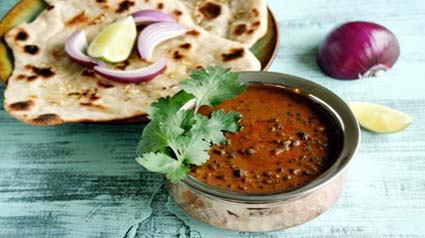
|
|
The mix of tradition and welcoming innovations can be very much seen in the costumes of the people of Chandigarh. As in any cosmopolitan city the people of Chandigarh also follow modern outfits. However the traditional men's costume is the resplendent and sophisticated Sherwani which in the latest years is invested with Western-eastern fusion and is in keeping with the contemporary air and traditional choices. Otherwise the men of Chandigarh are seen with their normal outfit which includes long-sleeved shirt, with tie, coat and formal trousers for the office goers.T-shirts are also quite common. The costumes of the people looks very rich with the famous Zardozi work which is a kind of gorgeous Persian embroidery, decked with stones, gold and silver thread and present with copper wire, with gold sheen, or gold coloured thread and embroidery designs.
The women living in the urban area of Chandigarh wear both Indian and western outfits. Their costumes mainly include salwar-kameez, sari, kurtis, jeans, shirts, T-shirts and formal/casual trousers. But however Salwar Kameez is allfavourite costume of the women of Chandigarh. Though the rest of the country also has salwar kameez as their costume, the suits of this area differs by their extraordinary work like mirror and Kundan embroidery, Persian embroidery, Aari and Resham work. There are different other patterns ofsalwar suits which includes Cut-work salwar-kameez, golden filigree salwars-suits, vegetable dye kurta churidar, Phirozisalwars, handloom jacquard salwar suit, camric cotton salwar suit and chikan suit.

|
|
Chandigarh has a rich tradition of folk dances, borrowed from the parent states of Punjab and Haryana. The people of the city are very lively and celebrate all the occasions to the fullest, with the folk dances accompanying each of them almost always. Bhangra, Giddha, Jhumar, Luddi, Julli, Dhamal, Sammi, Jaago, Teeyan, Dankara, Kikili and Gatka are some of the popular folk dances of the city.
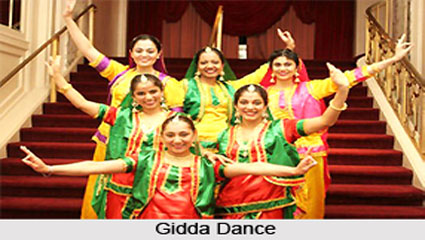
|
|
Chandigarh is a land of fairs and festivals. The people of this city observe all the festivals with proper rituals and traditions. The main festivals observed by the people in Chandigarh are Baisakhi, Gurpurab, Holla Mohalla, Lohri, Tika, Karva Chauth, Raksha Bandhan, Rose festivals, Dusshera and Diwali. All of them are celebrated with equal merriment and enthusiasm.
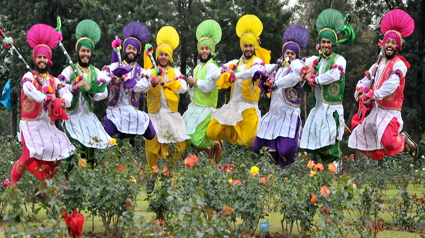
|
|
Every year in the month of February the people of Chandigarh never fail to celebrate the 'Rose Festival' during which varities of roses are kept in the Zakir rose garden. The festival is accompanied by performances of music and dance; both classical and folk, exhibitions by local artists, photographers and craftsman. During the Teej festival the women folk of the city sing and dance for the folk songs welcoming the monsoon season. This is actually conducted in the Rock garden where lot ofstalls on women accessories like bangles, mehndi and other makeup utilities are kept in display. During the Mango festival the people of Chandigarh invite the Mango-growers from all over India to display their mangoes in the show. The people of Chandigarh very excitedly prepare jams, pickles and canned fruits and display it to taste and sale. Lohri is the most common festival celebrated by the people of Chandigarh and it signifies the harvest of Rabi crops. Once the harvest is complete the people clean up the place and lit bonfire and along with friends and family gather around the fire singing folk songs and throw sweets, puffed rice and popcorn into the flames as a part of their customs and traditions. During the day time on Lohri the children go from house to house singing songs in praise of Dulha Bhatti, a Punjabi version of Robin Hood who helped the poor by robbing from the rich. The bonfire is also accompanied by traditional dinner namely the makki-ki-roti.On this occassion people also give gifts and presents to their newly married daughters.
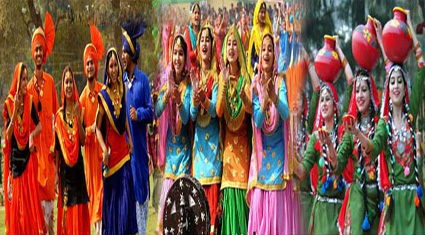
|
|
- Blue Pottery.
- Phulkari.
- Chikankari.
- Hewa Jewellery.
- Papier Mache.
- Thangka Paintings.
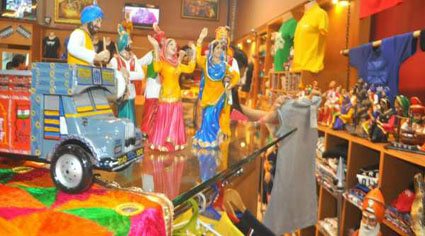
|
|







